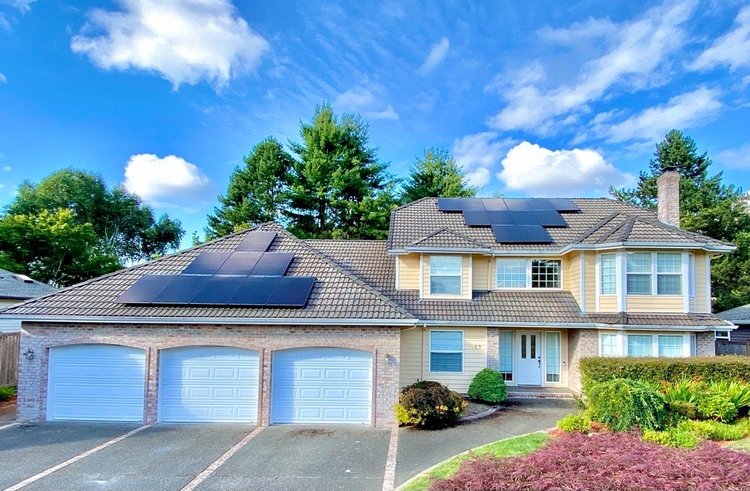Courtesy of NWES
You really can have sunshine on a cloudy day. Or, at least, you can produce solar energy.
For years, a lot of people in the Pacific Northwest—particularly Washington State—were skeptical of solar panels because of the region’s cloudy (and often rainy) weather. But more consumer education, increasing electricity prices and desires to ‘go green’ have pushed more homeowners than ever to look at solar.
Add increasing support for solar both at the state and federal level, and it’s caused the industry to expand significantly.
Speaking with Scanifly, five different contractors across Washington and Oregon—Tim Wachtman, Director of Operations at Capstone Solar; Thomas Gutierrez, a solar sales member at Artisan Electric; Gary Ingram, an independent solar consultant in Washington state; Diallo Josey, an employee-owner at A&R Solar; and Manuel Larrain, a solar specialist at Northwest Electric and Solar (NWES)—shared their perspectives on what’s going on now and what the future of solar holds for the region.
Why was solar adoption in the past slower in the Pacific Northwest?
Diallo: People in Washington and Oregon used to question why solar was necessary in our region. They look at other states like California or Arizona and say it’s a no-brainer there because it’s so sunny, but the clouds and rain in our region limit what solar can do.
Gary: In the areas I work, there’s always been an interest in solar. Early on, people were particularly focused on the ROI—how fast it would pay them back and how soon they could make money on it. Over time, while the financial considerations are still important, it seems like more people are becoming interested in the positive environmental impact of going solar.
What changed people’s perspectives from then to now?
Manuel: More people have a much better understanding of the technology behind solar now compared to ten years ago. They know it can generate electricity even on cloudy days. There’s also a better understanding of net metering. Hence, people see that they utilize our long summers to build up credits and save money on electricity throughout the Winter.
Tom: Net metering is absolutely what makes solar work in the Pacific Northwest. We have long summer days, so we typically produce way more electricity than we can use during the summer months. With net metering, credits for that excess energy can be used by the homeowner to offset their utility bill during the winter months.
Gary: The price of electricity is a huge unknown. We’ve had very reasonably priced electricity so far, but the utilities are currently requesting increases, and there will undoubtedly be more to come. Consumers are becoming more aware of the need for a financially sustainable alternative—that’s where solar comes in.
What types of people are seeking out solar in Washington and Oregon?
Diallo: It used to just be affluent people seeking out solar. Now we see all types of people. The interesting thing is that solar is almost like a social status thing in the Pacific Northwest. It’s not the same as having a luxury car, but instead, it’s a status symbol that you care about your community and you’re trying to do good things for yourself and the community.

Courtesy of Capstone Solar
Manuel: The biggest change I’ve seen is that lower-income people seek out solar. They may not be able to afford a system to offset their whole electricity usage. Still, even a smaller system is giving them some offset and helping them control their electricity bills more.
Tim: All types of people are interested in solar now for various reasons. But one weird situation is when people seek out solar for environmental reasons but then learn they have to cut down some trees to avoid shading the panels. It’s almost a moral conundrum—they want to save the trees and do the right thing by going solar, so they aren’t sure what to do sometimes.
What’s continuing to drive demand for solar in the region?
Tim: We’ve seen a two-part split. On the western side of the Pacific Northwest, it’s a lot of people who are green-minded. They care about the ROI, of course, but see this as an environmental project as much as a financial one. The other segment approaches solar from a much more independence-focused mindset. They want to invest in becoming more independent and potentially going off-grid in the future.
Manuel: People want to future-proof their homes and their finances. Solar is a great solution to hedge against increasing electricity costs. Especially as we push for the electrification of homes and spend more time at home due to remote work. Managing how you use, generate and store your electricity will give homeowners energy independence as we move forward into more times of economic and climate uncertainty.
Diallo: It comes down to three things: the social status of doing something good for your community, setting yourself up for grid independence, and the economics of it all.

What’s your take on the future of solar in the Pacific Northwest?
Gary: Air conditioning is essential in the areas east of the Cascade mountains, and there is plenty of sun. While lower population density makes servicing this area more difficult than the West side, demand will continue to increase along with increasing power bills. We’re also seeing more heat pump usage on both sides of the Cascades, which will further drive demand for electricity (and by extension, solar).
Manuel: In the future, we’re going to see more fully off-grid projects. There’s an increasing demand for a premium, integrated off-grid system. One that utilizes off-grid tailored equipment rather than a hacked-together mix of panels and batteries that look like a high school science project. We’ll also see more building-integrated solar photovoltaic technology, such as Tesla Solar Roof Tiles. Giving affluent customers or homeowners needing to replace their roofs before installing solar an aesthetically pleasing option generates heaps of solar energy.
Diallo: There will be a lot of demand for batteries and how home solar systems connect to electric vehicles. Not only will demand for electric vehicles increase demand for electricity, there’s also the future of bidirectional charging where the battery in your car can store energy for your home and vice versa.
Tim: Solar is growing and will continue to grow, particularly as states want to move off of coal and governments support solar adoption. The real issue will be around skills—we need to get more people interested in the industry and properly trained with new tools. It’s the only way to meet the growing demand.
Tom: Solar is just getting going in the Pacific Northwest. There’s huge buzz here, particularly with new bills and laws at the state and federal level incentivizing solar adoption. Folks are already on board with it, they know it works, and now it’s just a matter of meeting demand.






